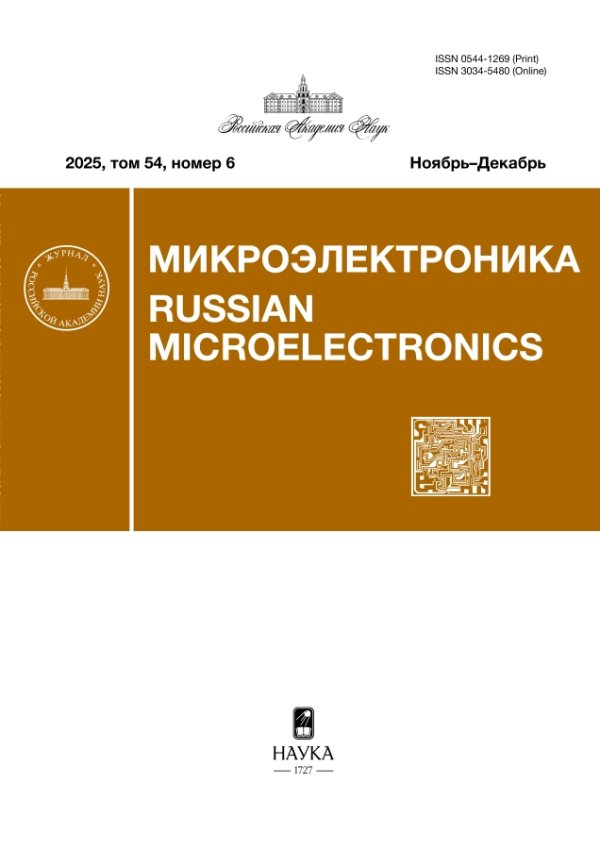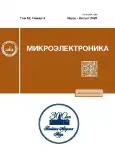Mechanisms of the Redistribution of Carbon Contamination in Films Formed by Atomic Layer Deposition
- Authors: Fadeev A.V.1, Myakon’kikh A.V.1, Smirnova E.A.1, Simakin S.G.2, Rudenko K.V.1
-
Affiliations:
- Valiev Institute of Physics and Technology, Russian Academy of Sciences
- Valiev Institute of Physics and Technology, Yaroslavl Branch, Russian Academy of Sciences
- Issue: Vol 52, No 4 (2023)
- Pages: 336-344
- Section: ТЕХНОЛОГИИ
- URL: https://journal-vniispk.ru/0544-1269/article/view/138582
- DOI: https://doi.org/10.31857/S0544126923700412
- EDN: https://elibrary.ru/IAEJRT
- ID: 138582
Cite item
Full Text
Abstract
The depth distribution of carbon impurities in hafnium oxide films obtained by plasma-assisted atomic layer deposition is studied experimentally and theoretically. An analytical model is proposed that describes the dependence of the carbon impurity concentration profile in the film. The model takes into account the fact that the formation of a carbon impurity in the growing film may be caused by the incomplete oxidation of the organometallic precursor. The diffusion redistribution of impurities is determined by mech-anisms that take into account the presence of carbon in different kinds of states: an insoluble state (carbides, carbonates), a highly mobile state (CO, CO2), and an unstable state whose lifetime is longer than the film’s growth time. The possibility of controlling the carbon impurity both in deep and near-surface layers is shown. The predictions of the model are confirmed experimentally using the mass spectrometry of the secondary ions in the films obtained by atomic layer deposition. To test the theory, special structures of hafnium oxide are developed, consisting of several layers, in which the time of the plasma exposure to the sample is varied at the same dosage of the organometallic precursor. The layer with the shortest exposure time to the plasma is deposited on the substrate, then the same number of cycles on the next layer take place, provided that the exposure time is increased by a factor of n. This makes it possible to deepen the transition zones and thus pro-tect them from the effects of the atmosphere.
About the authors
A. V. Fadeev
Valiev Institute of Physics and Technology, Russian Academy of Sciences
Email: alexvfadeev@gmail.com
Moscow, 117218 Russia
A. V. Myakon’kikh
Valiev Institute of Physics and Technology, Russian Academy of Sciences
Email: alexvfadeev@gmail.com
Moscow, 117218 Russia
E. A. Smirnova
Valiev Institute of Physics and Technology, Russian Academy of Sciences
Email: alexvfadeev@gmail.com
Moscow, 117218 Russia
S. G. Simakin
Valiev Institute of Physics and Technology, Yaroslavl Branch, Russian Academy of Sciences
Email: alexvfadeev@gmail.com
Yaroslavl, 150007 Russia
K. V. Rudenko
Valiev Institute of Physics and Technology, Russian Academy of Sciences
Author for correspondence.
Email: alexvfadeev@gmail.com
Moscow, 117218 Russia
References
- Atomic Layer Deposition of Nanostructured Materials. // Edited by Nicola Pinna and Mato Knez. Wiley-VCH Verlag & Co. KGaA, Germany, 2012. 435 p.
- Uenuma M., Takahashi K., Sonehara S., Tominaga Y., Fujimoto Y., Ishikawa Y., Uraoka Y. Influence of carbon impurities and oxygen vacancies in Al2O3 film on Al2O3/GaN MOS capacitor characteristics // AIP ADVANCES 2018. V. 8. P. 105103.
- Kinnunen S., Arstila K., Sajavaara T. Al2O3 ALD films grown using TMA + rare isotope 2H216O and 1H218O precursors // Appl. Surf. Sci. 2021. V. 546. P. 148909.
- Vihervaara A., Hatanpää T., Mizohata K., Chundak M., Popov G., Ritala M. A low-temperature thermal ALD process for nickel utilizing dichlorobis(triethylphosphine)nickel(II) and 1,4-bis(trimethylgermyl)-1,4-dihydropyrazine // Dalton Trans. 2022. V. 51. P. 10898.
- Chung H.K., Won S.O., Park Y., Kim J.-S., Park T.J., Kim S.K. Atomic-layer deposition of TiO2 thin films with a thermally stable (CpMe5)Ti(OMe)3 precursor // Appl. Surf. Sci. 2021. V. 550. P. 149381.
- Butcher K.S.A., Georgiev V., Georgieva D., Gergova R., Terziyska P., Binsted P.W. Downstream Electric Field Effects during Film Deposition with a Radio Frequency Plasma and Observations of Carbon Reduction // Coatings. 2022. V. 12. P. 1581.
- Kia A.M., Speulmanns J., Bönhardt S., Emara J., Kühnel K., Haufe N., Weinreich W. Spectroscopic analysis of ultra-thin TiN as a diffusion barrier for lithi.um-ion batteries by ToF-SIMS, XPS, and EELS // Appl. Surf. Sci. 2021. V. 564. P. 150457.
- Sultan S.M., Clark O.D., Masaud T.B., Fang Q., Gunn R., Hakim M.M.A., Sun K., Ashburn P., Chong H.M.H. Remote plasma enhanced atomic layer deposition of ZnO for thin film electronic applications // Microelectronic Engineering. 2012. V. 97. P. 162–165.
- Alen P., Juppo M., Ritala M., Sajavaara T., Keinonen J., Leskela M. Atomic Layer Deposition of Ta(Al)N(C) Thin Films Using Trimethylaluminum as a Reducing Agent // J. The Electrochemical Society. 2001. V. 148(10). P. G566–G571.
- Knoops H.C.M., Peuter K., Kessels W.M.M. Redeposition in plasma-assisted atomic layer deposition: Silicon nitride film quality ruled by the gas residence time // Appl. Phys. Lett. 2015. V. 107. P. 014102.
- Abdulagatov A.I., Ramazanov Sh.M., Dallaev R.S., Murliev E.K., Palchaev D.K., Rabadanov M.Kh., Abdulagatov I.M. Atomic Layer Deposition of Aluminum Nitride Using Tris(diethylamido) aluminum and Hydrazine or Ammonia // RUSSIAN MICROELECTRONICS. 2018 V. 47. № 2. P. 118–130.
- Cho M., Kim J.H., Hwang C.S. Effects of carbon residue in atomic layer deposited HfO2 films on their time-dependent dielectric breakdown reliability // Appl. Phys. Lett. 2007. V. 90. P. 182907.
- Kwon O.K., Kim J.H., Park H.S., Kanga S.W. Atomic layer deposition of ruthenium thin films for copper glue layer // J. The Electrochemical Society. 2004. V. 151(2). P. G109–G112.
- Kinnunena S.A., Malma J., Arstila K., Lahtinenb M., Sajavaara T. This is an electronic reprint of the original article. This reprint may differ from the original in pagination and typographic detail // Nuclear Inst. and Methods in Physics Research B. 2017. V. 406. P. 152–155.
- Hwan J.H., Kim H.Y., Lee S.C., Park K.J.-S., Jeon D., Chung T.-M., Kim C.G. Growth of tantalum nitride film as a Cu diffusion barrier by plasma-enhanced atomic layer deposition from bis((2-(dimethylamino)ethyl)(methyl)amido)methyl(tert-butylimido)tantalum complex // Applied Surface Science. 2016. V. 362. P. 176–181.
- An K.-S., Cho W., Sung K., Lee S.S., Kim Y. Preparation of Al2O3 Thin Films by Atomic Layer Deposition Using Dimethylaluminum Isopropoxide and Water and Their Reaction Mechanisms // Bull. Korean. Chem. Soc. 2003. V. 24(11). P. 1659–1663.
- Choi S.-W., Jang C.-M., Kim D.-Y., Ha J.-S. Plasma Enhanced Atomic Layer Deposition of Al2O3 and TiN // J. Korean Physical Society. 2003. V. 42. P. S975–S979.
- Chesnokov Y.M., Miakonkikh A.V., Rogozhin A.E., Rudenko K.V., Vasiliev A.L. Microstructure and electrical properties of thin HfO2 deposited by plasma-enhanced atomic layer deposition // J. Materials Science. 2018. V. 53(10). P. 7214–7223. https://doi.org/10.1007/s10853-018-2099-5
- Yoo Y.W., Jeon W., Lee W., An C.H., Kim S.K., Hwang C.S. Structure and Electrical Properties of Al-Doped HfO2 and ZrO2 Films Grown via Atomic Layer Deposition on Mo Electrodes // ACS Appl. Mater. Interfaces. 2014. V. 6(24). P. 22474–22482.
- Choi M.-J., Park H.-H., Jeong D.S., Kim J.H., Kim J.S., Kim S.K. Atomic layer deposition of HfO2 thin films using H2O2 as oxidant // Applied Surface Science 2014. V. 301. P. 451–455.
- Parka I.-S., Leeb J., Yoonb S., K. J. Chungb, Leeb S., Parkb J., Kimb C.K., Ahn J. Oxidant Effect on Resistance Switching Characteristics of HfO2 film Grown Atomic Layer Deposition // ECS Transactions 1007. V. 11(7). P. 61–66.
- Hodson C.J., Singh N., Heil S., van Hemmen H., Kessels E. Optimization of Plasma Enhanced Atomic Layer Deposition Processes for Oxides // Nitrides and Metals in the Oxford Instruments FlexAL Reactor. 2007. https://doi.org/10.1149/1.2721476
- Lee S.Y., Kim H.K., Lee J.H., Yu I.-H., Leea J.-H., Hwang C.S. Effects of O3 and H2O as oxygen sources on the atomic layer deposition of HfO2 gate dielectrics at different deposition temperatures // J. Mater. Chem. C. 2014. V. 2. P. 2558–2568.
- Fadeev A.V., Rudenko K.V. Possibility of Controlling the Impurity Concentration in the Near-Surface Layers of Films Grown by the ALD Method // Russian Microelectronics. 2019. V. 48(4). P. 220–228.
- Berdova M., Wiemer C., Lamperti A., Tallarida G., Cianci E., Lamagna L., Losa S., Rossini S., Somaschini R., Gioveni S., Fanciulli M., Franssila S. Protective coatings of hafnium dioxide by atomic layer deposition for microelectromechanical systems applications // Appl. Surf. Sci. 2016. V. 368. P. 470–476.
- Perros A.P., Sippola P., Arduca E., Johansson L., Lipsanen H. Low temperature and high quality atomic layer deposition HfO2 coatings // IMAPS Nordic Conference on Microelectronics Packaging (NordPac). 2017. P. 182–185.
- Maesa J.W., Fedorenkoa Y., Delabieb A., Ragnarssonb L.-Å., Swertsa J., Nynsb L., Elshochtb S., Wangc C.G., Wilk G. Impact of Hf-precursor choice on scaling and performance of high-k gate dielectrics // ECS Transactions. 2007. V. 11(4). P. 59–72.
- Liu X., Ramanathan S., Longdergan A., Srivastava A., Lee E., Seidel T.E., Barton J.T., Pang D., Gordon R.G. ALD of Hafnium Oxide Thin Films from Tetrakis (ethylmethylamino) hafnium and Ozone // ECS J. Solid State Sci. Technol. 2005. V. 152(3). P. G213.
- Kim K.D., MPark H., Kim H.J., Kim Y.J., Moon T., Lee Y.H., Hyun S.D., Gwona T., Hwang C.S. Ferroelectricity in undoped-HfO2 thin films induced by deposition temperature control during atomic layer deposition // J. Mater. Chem. C. 2016. V. 4. P. 6864–6872.
- Vos M., Grande P.L., Venkatachalam D.K., Nandi S.K., Elliman R.G. Oxygen Self-Diffusion in HfO2 Studied by Electron Spectroscopy // PRL. 2014. V. 112. P. 175901.
- Zafar S., Jagannathan H., Edge L.F., Gupta D. Measurement of oxygen diffusion in nanometer scale HfO2 gate dielectric films // Appl. Phys. Lett. 2011. V. 98. P. 152903.
- Xiao B., Watanabe S. Non-negligible Metal Ions Diffusion in Amorphous Oxygen-Deficient Metal-Oxide Based Resistive Switches: A First Principle Study // The Japan Society of Applied Physics. 2014.
- Shen W., Kumari N., Gibson G., Jeon Y., Henze D., Silverthorn S., Bash C., Kumar S. Effect of annealing on structural changes and oxygen diffusion in amorphous HfO2 using classical molecular dynamics // J. Appl. Phys. 2018. V. 123. P. 085113.
Supplementary files














